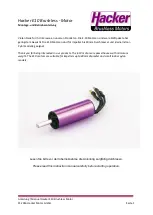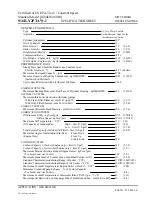
Tube
(
A
)
Check Valve
Tube
(
B
)
31
45
48
87
97.4
20
Valve Cover Screws
Fuel Filter
High Speed needle Valve
Low Speed needle Valve
TAPPET CLEARANCE ADJUSTMENT
1. Tappet clearance is factory preset. No adjustment is necessary until
after 1 hour of operation (including break-in period).
2. Clearance adjustment should be done when the engine is cool. When
the engine temperature is high, clearance is higher due to thermal
expansion.
3. The proper clearance setting should be at 0.04-0.1mm. The adjustment
is achieved by loosening the locknut (fig.2) and turning the adjusting
screw. Tighten the locknut after the adjustment is achieved. Alter the
initial 1 hour adjustment, this procedure should be performed a few
every 2 hours of use.
CAM GEAR TIMING ADJUSTMENT
If for some reason you have to disassemble your engine, please follow
these important steps on reassembling the cam gear.
1. Remove the carburetor and backplate assembly. Notice the impression
made on the crankshaft counterweight. Position it directly straight down
or in line with the case outer seam line.
2. When reinstalling the cam gear, the side with a point mark should be
facing the opening of the gear box. Note that it should also be mounted
with the point mark located towards the top of the engine just below
the cam followers.
DIAPHRAGM AND CHECK VALVE DISASSEMBLY
Diaphragm
1. Remove the adjustment screw of the valve, and then remove the inside
valve and spring.
2. Clean the inside with alcohol or appropriate cleaner. Reassemble.
3. Screw in the regulator screw until flush with the diaphragm body.
Check valve
1. Open the valve by rotating the body counterclockwise.
2. Reassemble the check valve carefully.
IMPORTANT! Silicone rubber is used in many parts of the YS engine.
Use only glow fuel or methanol for cleaning. Gasoline and other
volatile solutions will damage the silicone if used.
SPECIFICATIONS
Bore
24.0mm
Stroke
19.0mm
Weight (engine)
460g
(muffler)
33g
Practical rpm
2,000-15,000rpm
OPERATORS MANUAL
FZ53
Fig.1
FEATURES
The FZ53 is the most powerful 4 cycle engine of its size and was
developed for sport flying as well as power demanding acrobatics.
• Supercharged system
• Fuel injected
• Regulated and pressurized fuel system
• Muffler
The pressurized fuel and injection system makes throttle response
superior and is unaffected by tank level.
GLOW PLUG
Select the most appropriate plug from those designed specifically for
4 cycle engines. Glow plug selection greatly affects the maximum
engine output and low idle. We recommend the O. S. Type F Plug.
INSTALLATION
l.
Connect the engine to the tank as shown in fig.1. Since high pressure
is applied to the tank, tighten all connections carefully. Care must be
taken to prevent pressure leakage due to under tightening of the check
valve or by kinking the fuel lines.
2. Always use a fuel filter. We recommend the YS fuel filter.
3. Match the direction of the check valve arrow fig.1 with the arrow facing
to wards the tank.
PROPELLER INSTALLATION
Due to the high torque of the FZ53 engine, we have equipped it with
a double lock system for safety.
1. Mount the propeller and tighten the rear nut. Next, tighten the front
nut as shown in Fig.1.
2. Select a good quality propeller that will turn in the 9,000 to 11,000
rpm range. We recommend sizes 10x9-10x10, 11x7-11x8,12x7-12x8.
START UP
1. Remove tube B from the filter: remove tube A from the check valve,then
fill the tank. (CAUTION: If tank is filled or under pressure remove
tube A first, then tube B. Fuel will eject if tube B is removed while the
tank is pressurized. )
2. Open the needle valve 2 l/2 turns from the fully closed position.
3. Open the throttle fully and slowly turn the propeller 10 times. This
primes the system by pressurizing the tank and sending fuel to the
carburetor.
4. Close the throttle to the idle position and connect the glow plug battery.
The engine is now ready for starting.
DO NOT ATTEMPT TO START FULL THROTTLE,
AS THIS IS VERY DANGEROUS.
,
BREAK IN
To maximize engine performance and increase durability, please follow
this break-in procedure:
l.
Use the same size (or slightly smaller) propeller than you intend to
use in flying.
2. Use a good quality fuel which contains 15-30% nitromethane and oil
content of 20-24%. Synthetic or castor oil can be used, or a combination
of synthetic and castor.
Do not use four cycle fuel due to low oil content.
3. The needle valve should be set so that the engine is running at a rich
setting. Run the engine approximately 20 minutes with this setting.
4. Mount the engine to the model and fly ten times with this setting.
This concludes the break-in procedure, it is advisable to always use
a slightly rich setting to keep the moving parts lubricated, even after
the break-in period .
HIGH SPEED ADJUSTMENT
1. Adjustment of high speed is done by the carburetor needle valve.When
the needle valve is turned clockwise, the mixture is leaner.When it is
turned counterclockwise, the mixture is richer. A good starting position
for the high speed needle valve is 2 1/2 turns open from the fully
closed position.
2. When the engine is started, open the throttle gradually. Next, find the
peak position (highest RPM) by adjusting the needle valve. Then the
needle valve should be opened approximately 1/8 of a turn from full
RPM to achieve best performance. The engine may stop if the throttle
is opened to full immediately after starting. Wait until the engine
temperature rises and then open the throttle slowly .
3. For flying, it is advisable to use a slightly richer mixture setting. By
using a richer mixture, the engine temperature is maintained and RPM
stability improves.
LOW SPEED ADJUSTMENT
This engine is equipped with a new low speed needle valve to adjust
the mixture from low to mid throttle. This needle valve is located on the
side of the throttle barrel opposite the throttle arm (Fig.1).
1. Open the low speed needle to 1 turns from fully closed position.
2. The low speed needle valve should be set after the high speed needle
valve has been adjusted. Close the throttle gradually to a idle
(approximately 2500rpm). Let it idle for 20 to 30 seconds and then
slowly advance the throttle. The adjustment is satisfactory at low speed
if transition is smooth at this time.
3. If the engine is running rough on idle, the low speed mixture is rich.
If the engine starts to speed up and dies on idle or starts to detonate,
when advancing the throttle, the mixture is lean. Turn the low speed
needle valve clockwise to richen and counterclockwise for a leaner
mixture (note that the direction of the low speed needle valve is
opposite the high speed needle valve). Adjustments to the low speed
needle valve should be 1/8 to 1/4 of a turn increment at a time to
achieve smooth throttle response.
IMPORTANT! The regulator adjusting screw on this engine is
factory set. No further adjustments are necessary. If for some reason
you have to disassemble the regulator assembly, the regulator
adjusting screw should be set flush with the regulator body.
Fig.2
0.04 - 0.1mm




















